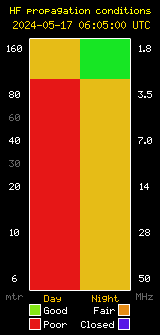![]()
This review of DX Engineering’s Radial Plate was prompted by the installation of a Four Square array, and a two element 40 Meter vertical array at NK7Z. I decided to evaluate each item in the building of the arrays separably, then review the entire system as a whole later. Years ago I had promised myself I would never spend fifty bucks on a piece of metal with holes in it. After making the decision to build a Four Square for 30 meters, and a two element phased array for 40 meters, I decided to revisit that decision, as I had a lot of ground radials to lay and connect to antenna bases.
My plan was to buy the needed parts for a single monopole, construct it as perfectly as I possibly could, and then duplicate that process for the other five antenna. Part of that process was to buy a radial plate for the ground radial system so I could keep all of the wire under control… I bit the bullet and bought one! I was pleasantly surprised when it arrived, it is so pretty… So perfectly built… So heavy… I actually didn’t feel so bad about spending fifty bucks on a piece of metal with holes in it!
The photo above, and on the DX Engineering web page does not do the plate justice… It really looks a lot better than the supplied photo from DX Engineering. The surface is smooth, the holes are sharp edged, and perfectly lined up, and in general the construction is a 10 out of 10 for quality.
Here is a short cut from the DX Engineering web site dealing with this device:
DX Engineering Radial Plates are made of 304 Stainless Steel, 1/8 inch thick and 11.625 in. x 11.625 in. outside dimensions. They are made with the finest Stainless Steel that will last! Not cheap aluminum that will dissolve in your soil!
“…..it is so beautiful, I want to frame it and put it up on the wall – not in the dirt under my vertical. Sebastian – NS0W”
Unique enough to be covered by two US Patents, the DX Engineering Radial Plate is meant for those of you that have or are building a quarter wave vertical antenna and who want an easy, neat and effective way to connect those essential radial wires and the coax to your vertical antenna for the lowest takeoff angle and strongest signals. Stainless steel construction assures that your signal won’t disappear like a disintegrating aluminum radial plate.
Will now fit up to 3″ OD Pipe! Saddle clamp to mount the DX Engineering Radial Plate to a ground mounted pipe is sold separately.
For STEEL pipe from 1″ to 2″ O.D. the all-Stainless Steel SSVC-2P is the recommended clamp.
For STEEL pipe from 2″ to 3″ O.D. the all-Stainless Steel SSVC-3P is the recommended clamp.
For pipe or rod whose O.D. is between 0.50 in. and 1.75 in. then the DXE-CAVS-11P V-saddle clamp is recommended. For tubing from 1 in.to 2 in. O.D., use the DXE-CAVS-2P V-saddle clamp.
Here is what I have to say about the Radial Plate:
All of what they say above is true, the thing is pretty, and the Radial Plate is solid feeling, there is zero flex in it, it is thick enough to take a pounding. This really is a nicely constructed Radial Plate. I really am a bit reticent to just put it in the dirt, outside…
It does come with a few surprises though. On the minus side, it only comes with 20 radial mounting screws, but has space for more, given that most hams will not put in more than 20 redials I guess this is fine, for me, I will most likely go to 32 at minimum, and maybe 64 radials, so I’ll be visiting the local hardware store for some Stainless Steel hardware. This is not a big deal for me, as mounting hardware is cheap.
Again however on the minus side– it does not come with the saddle clamp to mount the Radial Plate to the antenna mounting post, I am sure it says that someplace in the blurb for it, but I missed it… That did seem odd as DX Engineering included mounting clamps with the antenna I purchased, so I called them, sure enough they don’t include the saddle clamp. I really expected the base plate to have a saddle clamp with it, and was somewhat disappointed that it did not. Oh well, that will teach me to not fully read the blurbs for things… Rather than get something from the local hardware store, I decided to order the pole clamp from DX Engineering as this gave me an excuse to buy more snap on ferrite beads for another project.
On the plus side of things; I was pleasantly surprised to see a mounting hole for a chassis mount SO-239 on the plate. I elected to use a bulkhead connector there, as that seems a lot simpler to weather proof a bulkhead connector as opposed to an actual SO-239.
Will it work? Yes, I have constructed a number radial fields in the past, (some very large 128 radials), and they can become quite unruly if you let them, the DX Engineering Radial Plate will let me keep track of things one radial at a time, making for a very clean installation. The radial plate is also Stainless Steel, so it will not fall apart in a few years as many other plates have… All hardware is Stainless Steel as well, and as such I expect that things will last a few decades.
Cons:
- Does not include a full set of radial mounting screws, not really a big deal.
- Does not include the Saddle Clamp.
Pros:
- All Stainless Steel Construction.
- Absolutely perfect in construction.
- Will outlast any aluminium plate made.
- Helps keep a radial field under control.
Recommendation:
If you are putting together a vertical antenna, you had better be adding a correct radial field, (not four radials, but no less than 16 radials), and if you are adding a radial field, you should get a Radial Plate. I will be purchasing one DX Engineering Radial Plate for each antenna in the four square, and in the two element 40 meter phased array.
Photos:
Here is a photo of the radial plate mounted on the antenna mounting post, prior to insertion into the Earth. Note the orientation, and the spacing. This, I believe is the correct layout. The antenna will mount on the side away from the camera.
Here is a close up of the Radial connection screws. Each one was treated with a touch of Pentrox prior to assembly. This will help the electrical connection.
Coax connector in the location provided by the Radial plate. Note the connector is not the suggested SO-239, chassis mount, but a UG-239 bulkhead mount. I decided to use that type, as it seems a lot simpler to waterproof that, as opposed to a chassis connector. Note, again I used a bit of Pentrox. In fact, I used it on every connection regardless of location. The stuff is cheap, and easy to use. Plus it is good lucubration for the hardware as well as making sure everything is connected electrically.
Here is how it all fits together. Once the holes are dug, I will basically follow this plan.
Sponsors








